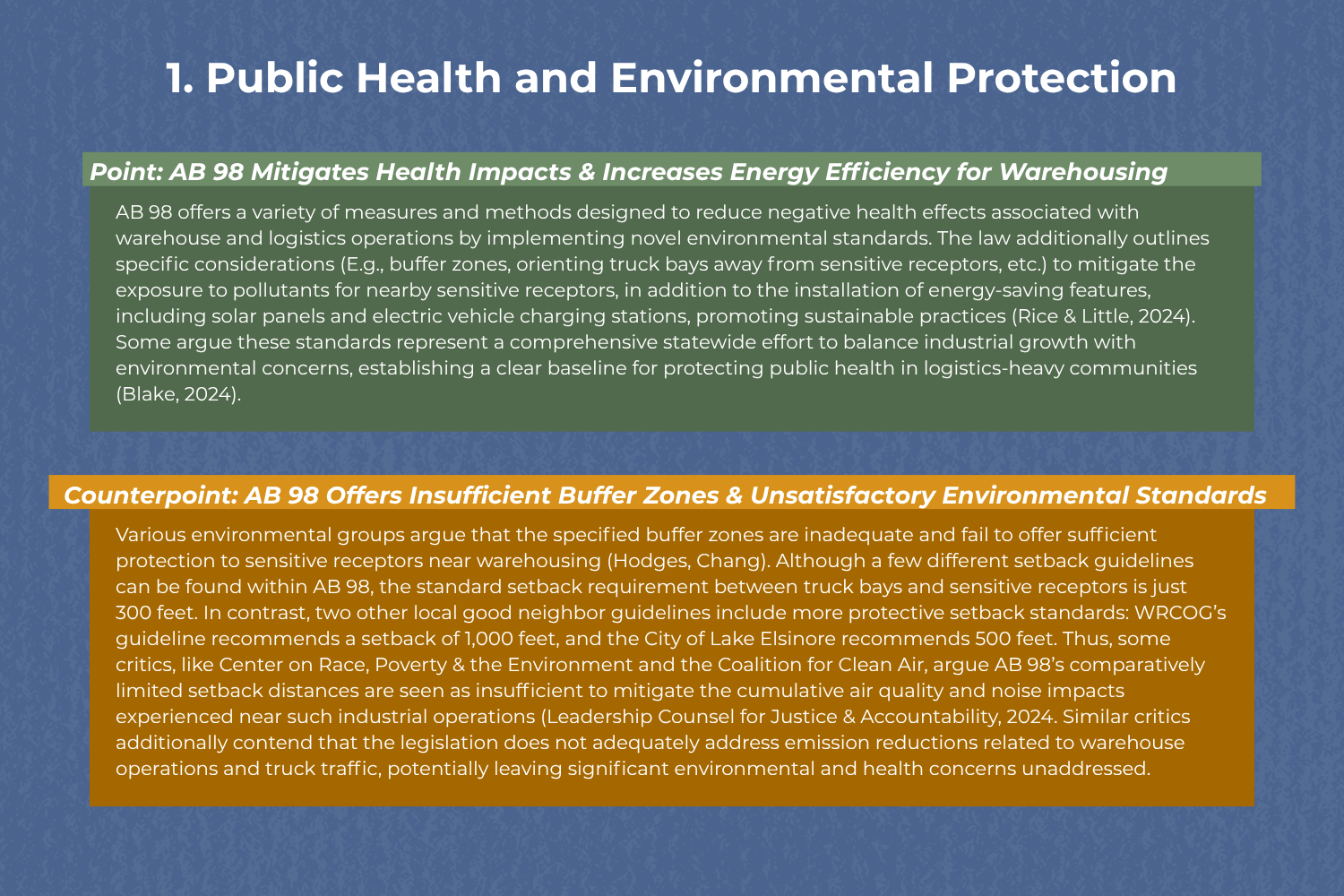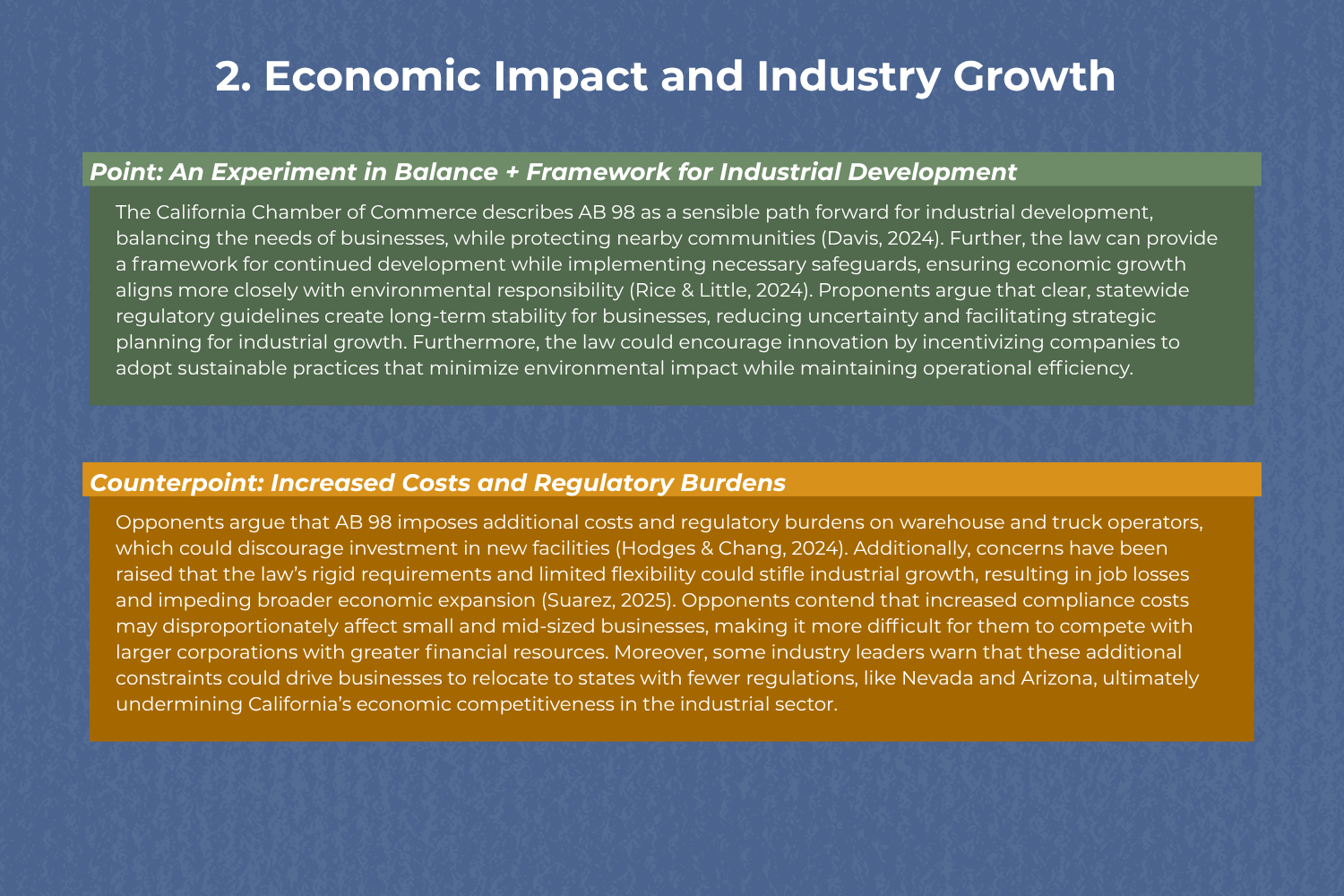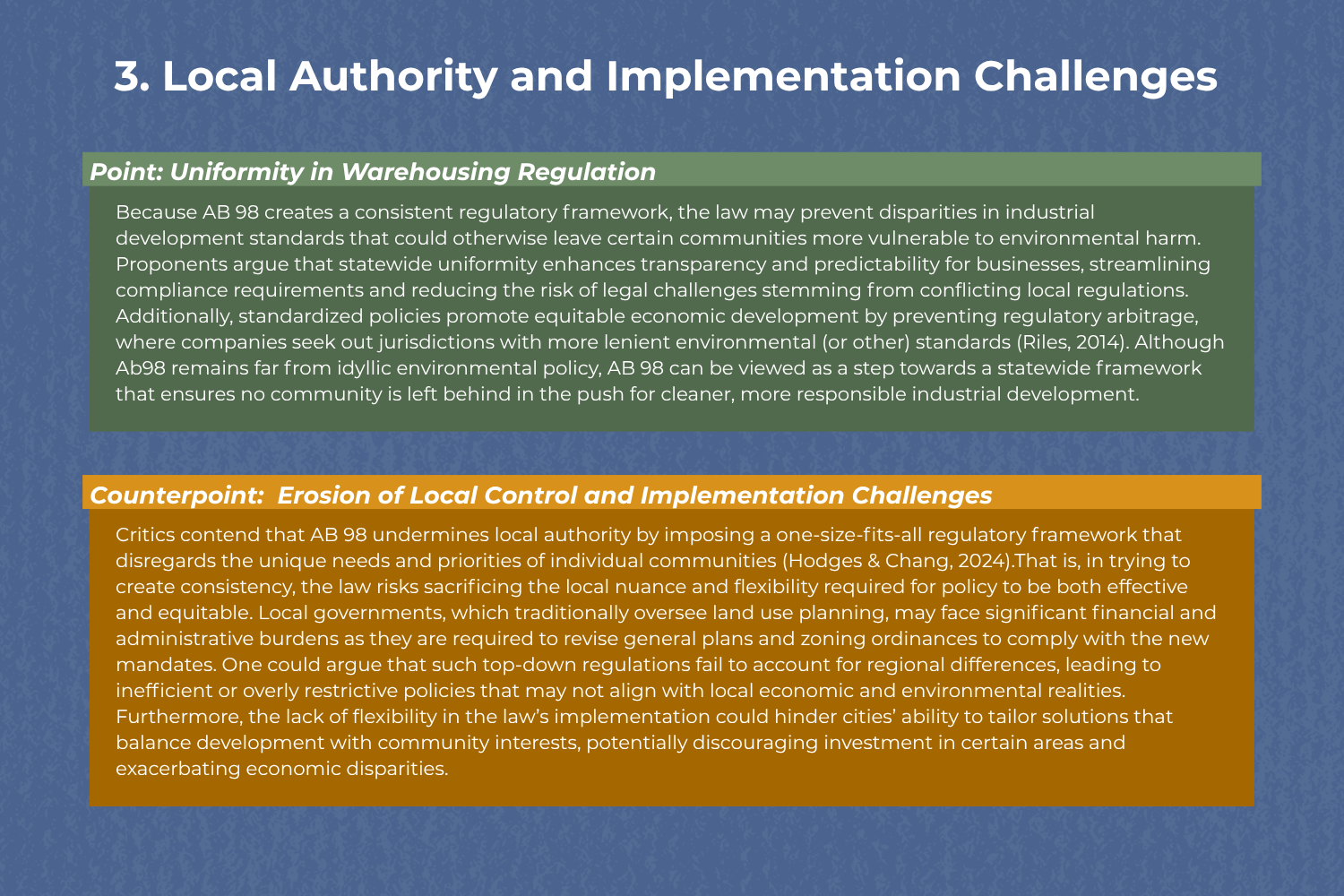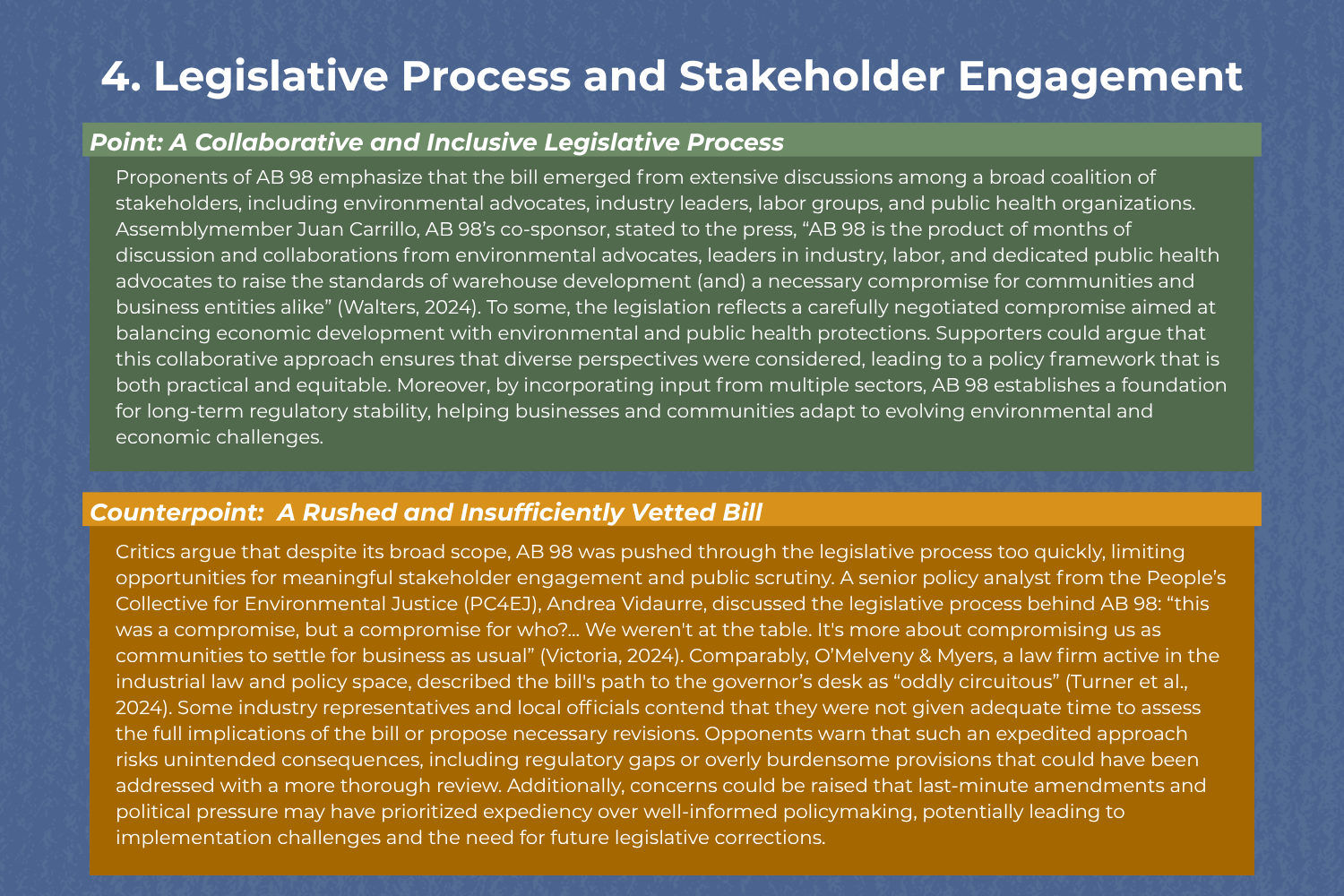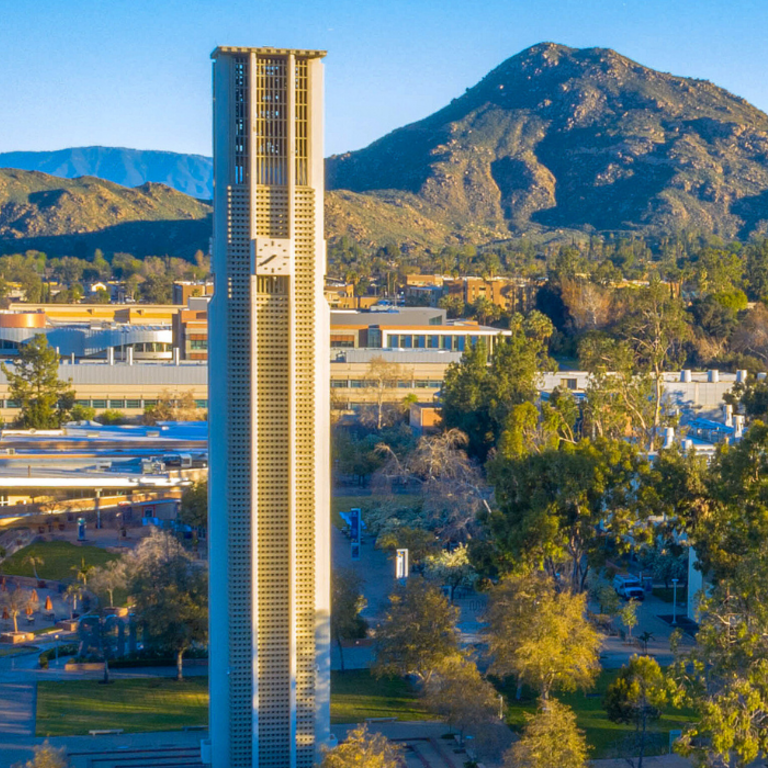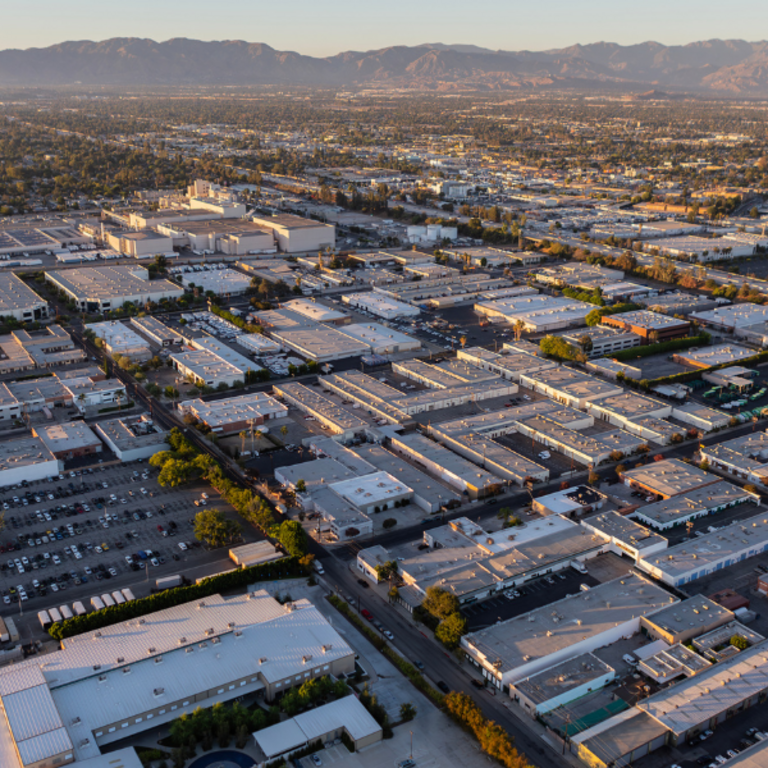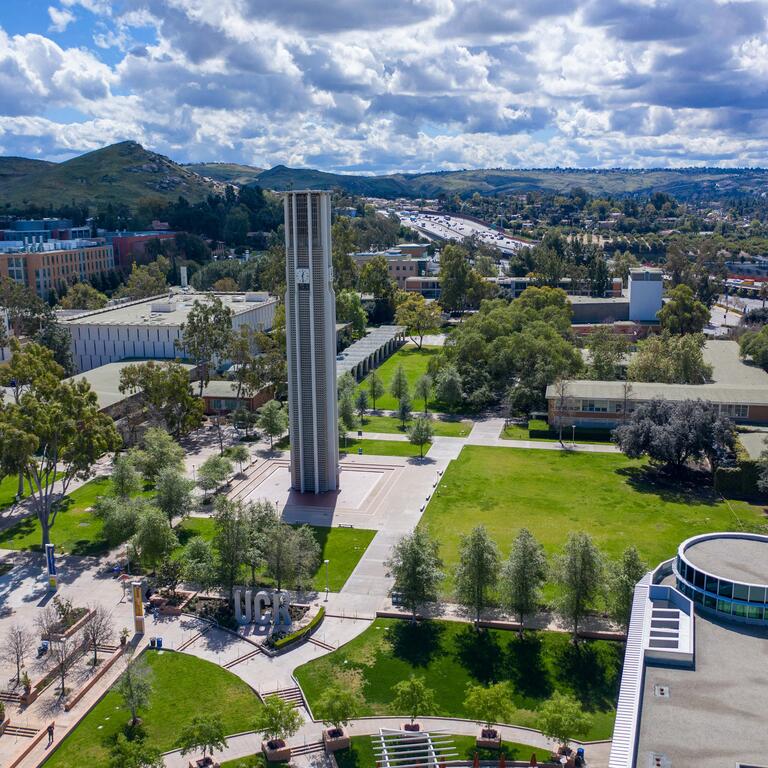I. Executive Summary
California’s Assembly Bill 98 (AB 98) represents a landmark shift in California’s approach to regulating logistics and warehousing developments, establishing a uniform framework for mitigating environmental and public health concerns associated with industrial expansion. AB 98 functions as a statewide good neighbor guideline, and introduces comprehensive building and design standards, including requirements for energy efficiency, electric vehicle infrastructure, and emissions reductions, alongside stringent setbacks and buffering requirements to protect sensitive receptors. AB 98 includes provisions to ensure public participation in decision-making processes related to warehouse regulations and environmental mitigation. Additionally, AB 98 mandates public engagement in the revision of general plans and circulation elements, requiring local governments to actively seek input from all economic segments of the community. These provisions align with existing local good neighbor guidelines, such as those in Riverside County and the Western Riverside Council of Governments (WRCOG), which emphasize community outreach, transparency, and collaborative problem-solving in warehouse development.
In this case study we discuss selected subcomponents of AB 98, and additionally summarize a few of the arguments for and against a statewide good neighbor guideline. While proponents argue that AB 98 provides much-needed statewide consistency in industrial regulation, protects public health, and fosters sustainable economic growth, critics contend that it imposes excessive financial and administrative burdens, particularly on local governments and small-to-midsize businesses. Concerns over the erosion of local authority and a potentially rushed legislative process further complicate the law’s reception. As California navigates the intersection of economic development and environmental responsibility, AB 98 serves as a key case study in balancing industrial growth with community and ecological well-being.
II. Overview of AB 98
With the expansion of California's logistics and warehousing industries, concerns over environmental degradation and public health have shifted from local land use matters to comprehensive statewide issues. Although signed into law almost 20 years after the enactment of California’s first good neighbor guideline, Assembly Bill No. 98 aimed to regulate the design, siting, and operation of logistics use developments at the state level. Unlike local ordinances and guidelines that vary by municipality or county, AB 98 establishes standardized truck route planning policies, industrial setback and design specifications, and landscaping requirements for the state. This section provides an overview of some of AB 98’s subcomponents including, design standards, public participation mechanisms, and a discussion of the special requirements for the Inland Region.
- Building + Design Standards
AB 98, as of January 1st, 2026, will establish design and building standards aimed at reducing environmental impacts from logistics developments and promoting sustainable building practices. These standards apply to new and expanded logistics facilities in California, particularly those with over 250,000 sq. ft. of floor area with loading bays less than 900 feet from a sensitive receptor. Specific building standards enforced by AB 98 include, requirements for energy efficiency, electric vehicle (EV) infrastructure, zero-emission equipment, and high-efficiency and HVAC systems. AB 98 additionally includes a 300 foot setback from “the property line of the nearest sensitive receptor to the nearest truck loading bay opening”, placing large zoning restrictions on industrial facilities throughout the state (Assembly Bill No. 98, 2024). Additional design standards, like truck routing and buffering, are detailed elsewhere in this case study.
- Buffering + Landscaping Requirements
AB 98 mandates specific buffering and landscaping requirements for logistics developments to reduce the impact of noise, emissions, and light pollution on nearby sensitive receptors, especially in areas where these facilities are close to residences, schools, or healthcare facilities or other sensitive receptors. Across California, logistics facilities within 900 feet of sensitive receptors must establish buffer zones ranging from 50 to 100 feet in width, depending on the development’s location and the proximity to sensitive receptors. These buffer areas must include a solid decorative wall, landscaped berm, or a combination of both at least 10 feet high, accompanied by drought-tolerant ground landscaping and proper irrigation to maintain plant health. Additionally, the buffer zones must feature solid-screen, drought tolerant evergreen trees planted in two rows.
- Signage Requirements
Similar to the local level guidelines, AB 98 includes detailed signage requirements to manage truck traffic, reduce idling, and clearly direct logistics facility operations within and around the site, especially near sensitive receptors. Facilities must post anti-idling signs at entrances and at truck loading bays, indicating a strict three-minute idling limit for heavy-duty trucks, which is intended to minimize diesel emissions in surrounding neighborhoods. At exit points, facilities are required to display signs directing drivers to designated truck routes, as specified in the facility’s truck routing plan, ensuring that trucks follow planned routes that avoid residential and sensitive areas. Additionally, AB 98 requires local jurisdictions to post visible signage for established truck routes and truck parking locations to streamline logistics traffic and prevent congestion in non-industrial areas. Jurisdictions must also make truck route maps publicly available in GIS format and share them with logistics operators, fleet operators, and drivers to support compliance and consistent use of designated paths.
- Housing: Replacement for Displacement
AB 98 includes specific provisions to address housing displacement caused by warehousing or industrial developments, aiming to mitigate the social impact on communities near logistics projects. If a logistics development requires the demolition of occupied housing units, the bill mandates a two-to-one replacement ratio for each unit demolished, ensuring that two units of affordable housing for low- and moderate-income residents are constructed for every demolished unit. These replacement units must be deed-restricted to maintain affordability, helping to ensure the housing remains accessible to vulnerable community members affected by logistics expansion. This targeted provision is likely a response to the overtly accommodating manner in which some localities have zoned warehousing within the warehousing concentration region. For example, both residential neighborhoods and school properties have been rezoned to accommodate the demand for warehousing in recent years (Whitehead, 2018; Mayorquin, 2022).
In addition to housing replacement, AB 98 provides compensation for displaced tenants. Developers must compensate each displaced tenant with a sum equivalent to 12 months of rent at the current rate, helping residents to secure alternative housing without immediate financial burden. To further support these housing provisions, any fees collected from developers for housing replacement are allocated to a housing-specific set-aside account, designated for use within three years of collection to fund local affordable housing projects. Through these housing displacement provisions, AB 98 seeks to balance the state’s economic growth with protections for community stability and housing security near expanding logistics hubs.
- Updates to Relevant General Plans + Circulation Elements + Truck Routes
AB 98 requires that local jurisdictions update their General Plans, specifically the Circulation Element, to manage and minimize the impact of increased truck traffic from logistics developments on local communities. By January 1, 2028 (or January 1, 2026 in the warehouse concentration region), each city and county must establish and publicly designate truck routes for the transport of goods to and from logistics facilities. These truck routes must prioritize interstate highways, arterial roads, major thoroughfares, and commercial roads, ensuring that trucks avoid residential neighborhoods and areas near sensitive receptors. Further, the bill empowers the California Attorney General to enforce compliance with these updates, with fines of up to $50,000 every six months for non-compliance, ensuring that jurisdictions prioritize effective and timely implementation of the updated circulation elements and truck routes. These updates aim to improve transportation efficiency and protect public health by directing logistics traffic along routes that limit community disruption
- Public Participation
Finally, AB 98 has a novel and specific public participation requirement relating to the funds produced by the Warehouse Indirect Source Rule #2305. The Warehouse Indirect Source Rule, enacted by SCAQMD applies to warehouses larger than 100,000 sq. ft., and similarly to AB 98, regulates warehouse facilities to reduce emissions from the goods movement industry. As part of their Indirect Source Rule, SCAQMD collects penalties for violations; AB 98 requires that SCAQMD establish a process for receiving community input on how those penalties are spent. Specifically, the bill states, “The south coast district shall ensure a wide range of community groups are included in the process and that groups represent the geographic areas where there are high numbers of warehouse facilities” §40522.7. This provision functions as a limited public engagement mechanism within AB 98. Although included to varying degrees and in different contexts, two local-level good neighbor guidelines also have community engagement requirements.
|
|
|
|
|
|
|
|
|
|
|
|
|
|
|
- Special Requirements for Warehouses within the Warehousing Concentration Region (Riverside + San Bernardino County)
AB 98 introduces stricter requirements for logistics facilities located within the warehousing concentration region, defined as, “the combined area of the Counties of Riverside and San Bernardino, including the entirety of the Cities of Chino, Colton, Fontana, Jurupa Valley, Moreno Valley, Ontario, Perris, Rancho Cucamonga, Redlands, Rialto, Riverside and San Bernardino” (Assembly Bill No. 98, 2024). These areas face high levels of industrial activity, and AB 98 implements more stringent standards to address the environmental and health risks unique to these regions. The warehousing concentration region has more stringent requirements in three key areas:
1) Accelerated compliance to update circulation elements and establish designated truck routes. The warehousing concentration subregion must update their circulation elements by January of 2026, two years ahead of the AB 98’s timeline for the rest of the state.
2) Increased buffering for landscaping + setback from loading bay requirements. For example, in the warehousing concentration subregion, truck loading bays must be located a minimum of 500 feet from the property line of the nearest sensitive receptor. The remainder of the state only has to comply with a 300 foot setback standard.
3) Specialized air quality monitoring by the South Coast Air Quality Management District (SCAQMD).
AB 98 – Warehousing Concentration Region Summary Table
|
|
|
|
|
|
|
|
|
|
|
|
|
|
|
|
|
|
|
|
|
|
|
|
|
|
|
|
|
|
Point/Counterpoint
As California continues to balance economic growth with environmental and public health concerns, AB 98 has emerged as a significant piece of legislation shaping industrial development and regulatory oversight. Proponents argue that the law establishes a fair and uniform framework, ensuring responsible expansion while protecting communities and fostering long-term sustainability. However, critics contend that AB 98 imposes excessive regulatory burdens, overrides local authority, and was rushed through the legislative process without sufficient stakeholder input. This point/counterpoint analysis examines the key question: What are the arguments for and against specific subcomponents of AB 98?
IV. Conclusion
AB 98 stands at the forefront of California’s efforts to harmonize industrial development with environmental and public health safeguards. By establishing statewide standards for logistics facilities, the law seeks to ensure that all communities—particularly those disproportionately impacted by industrial pollution—benefit from uniform protections. Proponents argue that this legislation offers a forward-thinking approach to sustainable development, fostering long-term regulatory stability and incentivizing greener business practices. However, opponents highlight concerns over the financial burden on local governments, the perceived erosion of municipal control, and the potential for unintended economic consequences. As implementation progresses, the effectiveness of AB 98 will be tested in its ability to both enforce environmental safeguards and support economic vitality. Future legislative refinements may be necessary to address stakeholder concerns and optimize the balance between industrial regulation and economic growth in California’s evolving logistics sector.
References
Blake, S. (2024). Assembly Bill 98 – New Rules for Development of California Warehouses. Blake Law Firm. https://www.blakelawca.com/articles/ab98
Cal. Health & Safety Code § 65302.02
City of Lake Elsinore Council Policy § 400-16
City of Fontana Council Ordinance No. 1891
City of Moreno Valley Municipal Code § 9.05.050
County of Riverside, California Board of Supervisors Policy No. F-3
City of Riverside Community Development Department Planning Division Resolution No. 23639
Cornejo, J. (2024, September 30). NAIOP SoCal Disappointed in Governor’s Signature of Anti-Logistics Bill. NAIOP: SoCal Chapter. https://www.naiopsocal.org/assets/pdf/NAIOP+SoCal+Disappointed+in+Governors+Signature+of+Anti-Logistics+Bill/
Davis, D. (2024, September 29). California Business Leaders Issue Statement on Governor Signing AB 98. California Chamber of Commerce. https://advocacy.calchamber.com/2024/09/29/california-business-leaders-issue-statement-on-governor-signing-ab-98/https://advocacy.calchamber.com/2024/09/29/california-business-leaders-issue-statement-on-governor-signing-ab-98/
Governor Newsom Signs Warehouse Development Bill, Ignores Environmental Justice Concerns. Leadership Council for Justice & Accountability. (2024, September 29). https://leadershipcounsel.org/governor-newsom-signs-warehouse-development-bill-ignores-environmental-justice-concerns/
Hodges, W., & Chang, L. K. (2024, October 10). A Deep Dive into AB 98’s Restrictions on the Logistics Industry: What the Bill Does and Does Not Do. National Law Review. https://natlawreview.com/article/deep-dive-ab-98s-restrictions-logistics-industry-what-bill-does-and-does-not-do
Mayorquin, O. (2022, May 2). When Residential Neighborhoods Are Rezoned for Warehouses. PBS Southern California. https://www.pbssocal.org/shows/earth-focus/when-residential-neighborhoods-are-rezoned-for-warehouses
Rice, J. B., & Little, K. O. (2024, October 14). AB 98: Redefining California Warehouses. Holland & Knight. https://www.hklaw.com/en/insights/publications/2024/10/ab-98-redefining-california-warehouses
Riles, A. (2014). Managing Regulatory Arbitrage: A Conflict of Laws Approach. Cornell International Law Journal, 63, 63–119. https://doi.org/10.2139/ssrn.2335338
Suarez, A. (2025, March 28). California Assembly Bill 98 and the Implications for Infill Development. NAIOP: Commercial Real Estate Development Association. https://blog.naiop.org/2025/03/california-assembly-bill-98-and-the-implications-for-infill-development/#:~:text=California%20Assembly%20Bill%2098%20(AB,for%20each%20residential%20unit%20demolished.
Turner, K. E., Kenyon, B., Byrd, E., & Hamilton, M. D. (2024, September 24). California Assembly Bill 98 Bringing Changes to Logistics Facility Regulations. O’Melveny. https://www.omm.com/insights/alerts-publications/california-assembly-bill-98-bringing-changes-to-logistics-facility-regulations/#:~:text=In%20favor%20of%20the%20bill,issues%20and%20other%20chronic%20conditions.
Victoria, A. (2024, September 2). California Lawmakers Push through Controversial Warehouse Bill at Last Minute despite Opposition. NPR, KVCR. https://www.kvcrnews.org/local-news/2024-09-02/california-lawmakers-push-through-controversial-warehouse-bill-at-last-minute-despite-opposition
Walters, D. (2024, September 6). Warehouse Regulation Bill Attracts Strange Bedfellows in Support and Opposition. Cal Matters.
Whitehead, B. (2018, September 26). San Bernardino County Supervisors Rezone Residential Land in Bloomington for Warehousing. San Bernardino Sun. https://www.sbsun.com/2018/09/25/san-bernardino-county-supervisors-rezone-residential-land-in-bloomington-for-warehouse/
(2005). (rep.). Good Neighbor Guidelines for Siting New and/or Modified Warehouse/Distribution Facilities. Riverside, CA.
By: Kristen Kopko, Jordan Quach
July 2025

